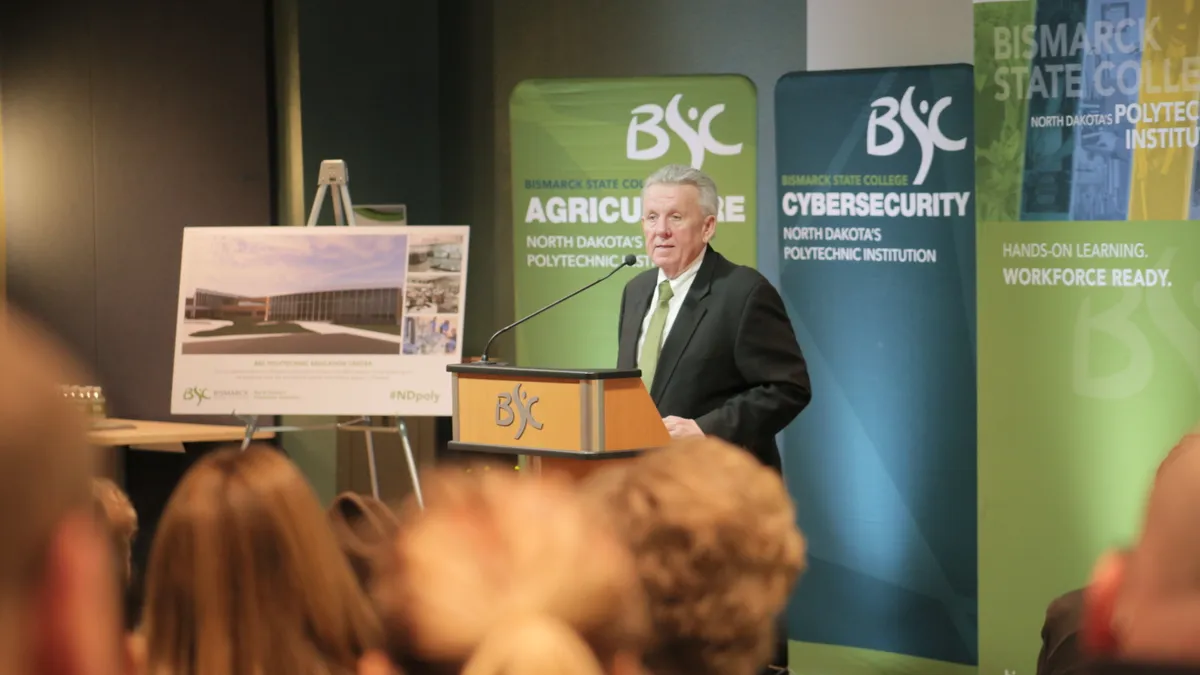Dive Brief:
- Bismarck State College, a public institution in North Dakota, is funding construction of a new polytechnic education building with $38 million in federal coronavirus relief money that was allocated to it by state lawmakers.
- The project is one of the first known uses of coronavirus aid to pay for a new facility on a college campus. Other institutions across the U.S. are requesting relief money be spent on capital projects, an attempt to tap buckets of federal money that were not targeted specifically for colleges.
- Bismarck State has pursued a mission of being a polytechnic institution since 2018, when the North Dakota State Board of Higher Education signed off on plans allowing the college to offer bachelor of applied science degrees in addition to existing certificates, diplomas and associate degrees.
Dive Insight:
Congress earmarked tens of billions of dollars over several relief packages for colleges to defray pandemic-induced costs and assist struggling students. But the legislation also set aside money for municipal and state governments to allocate.
Colleges in other states are lobbying policymakers to invest that relief funding in capital projects. Leaders at public colleges in Missouri last month made such a request to legislators, including the University of Missouri, which asked for $115 million for a new research center.
Many states have budget surpluses right now after the federal aid infusion, said Tom Harnisch, vice president for government relations at the State Higher Education Executive Officers Association.
Higher ed will be competing for those funds, Harnisch said.
"Budget surpluses aided by federal relief dollars provide an opportunity to make transformational investments in higher education and grow state economies," he said. "These generally would not be available in normal budget years."
The Biden administration's recently approved infrastructure package largely ignores higher ed, and so states should spend some of their aid funding on college facilities, Harnisch said.
SHEEO and other sector groups have advocated for more federal capital investments in higher ed. APPA-Leadership in Educational Facilities, the association for college facilities professionals, estimates public colleges have a $76 billion infrastructure backlog.
At Bismarck State, $35 million will go to building the polytechnic facility, which will include such features as nontraditional learning spaces and adaptive laboratory settings, said spokesperson Juanita Lee.
The remaining $3 million will pay for startup costs at the new center: curriculum development, faculty hires, new equipment and marketing funding, Lee said.
Bismarck State intends to break ground on the facility in early 2022.
“North Dakota has tremendous natural assets that support economic growth in our state," Bismarck State President Doug Jensen said in a statement. "The decision to invest in our polytechnic mission aligns perfectly with the state's economic growth projects."
The North Dakota bill sending money to Bismarck State also allocates funding for several capital projects at other state institutions, including $50 million for renovating an academic building at the University of North Dakota.
Some states have already translated their relief money into free tuition and workforce development programs.
South Carolina Gov. Henry McMaster devoted $17 million of the state's share of federal relief to funding tuition-free technical college for about 15,000 students in high-demand fields. McMaster urged the legislature to budget $124 million more to continue the program through June 2024.
And Michigan's governor last year appropriated $24 million in federal relief money to fund tuition-free college for workers who were on the frontline in the pandemic's early months.










